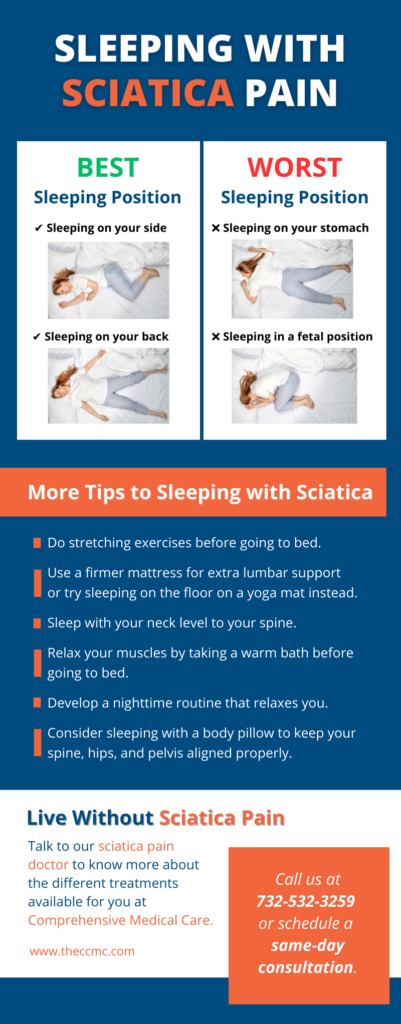We deliver to you every day from 7:00 to 23:00
The best discounts this week
Every week you can find the best discounts here.
How Do I Relieve Sciatica Pain at Night? A Comprehensive Guide
Sciatica pain, which originates from the sciatic nerve, can be extremely uncomfortable and disruptive to your daily life. For many individuals, this pain intensifies at night, making it difficult to sleep. Understanding why this happens and learning effective strategies for managing sciatica pain at night can help you improve your quality of life. This guide will explore some tried-and-tested methods to relieve sciatica pain at night, ensuring you wake up feeling more refreshed and less fatigued.
What is Sciatica?
Before diving into relief strategies, it’s important to understand what sciatica is. Sciatica refers to the pain that radiates along the path of the sciatic nerve, which runs from the lower back through the hips and buttocks and down each leg. Sciatica usually affects only one side of the body, and the pain can vary from a mild ache to sharp, burning sensations or even numbness and tingling.
Causes of Sciatica
Sciatica is not a condition in itself but a symptom of an underlying issue. The most common causes include:
-
Herniated or slipped discs that press on the nerve.
-
Spinal stenosis, or the narrowing of the spinal canal.
-
Degenerative disc disease, where discs in the spine wear down over time.
-
Piriformis syndrome, where the piriformis muscle irritates the sciatic nerve.
If you experience ongoing sciatic pain, consult with a healthcare provider to identify the exact cause and get personalized treatment.
Why Does Sciatica Pain Feel Worse at Night?
Many individuals notice that their sciatica pain intensifies when they lie down at night. There are several reasons why this may happen:
-
Pressure on the Nerves: When you lie down, especially if you’re not using the correct sleeping posture, pressure on the spine and nerves may increase, aggravating the pain.
-
Reduced Distraction: During the day, you might be distracted by other activities, while at night, the quiet and stillness allow you to focus more on the pain.
-
Increased Inflammation: Inflammation in the muscles and nerves can build up during the day and worsen while you sleep.
-
Poor Sleep Positions: Certain sleep positions can exacerbate sciatica pain by putting extra strain on the spine and the nerves.
Understanding these factors can help you implement strategies that reduce pain and improve your rest.
Effective Tips to Relieve Sciatica Pain at Night
There are various ways to reduce sciatica pain and improve sleep. The key is to combine several methods to find what works best for you. Below are some practical tips:
1. Find the Right Sleeping Position
One of the most effective ways to manage sciatica pain at night is by adjusting your sleeping position. Here’s how:
-
Sleep on your side: Lie on the side that is opposite the leg experiencing pain. Place a pillow between your knees to maintain proper alignment of your hips and spine.
-
Use a body pillow: A body pillow can support your back and legs, keeping them in a neutral position.
-
Avoid sleeping on your back: This can increase pressure on the lower back and worsen the pain.

2. Use Heat or Cold Therapy
Both heat and cold therapy can help reduce inflammation and soothe the muscles around the sciatic nerve. Here’s how to use them effectively:
-
Cold compress: Apply a cold pack wrapped in a towel to the affected area for 15-20 minutes. This can help reduce swelling and numb the pain.
-
Heat therapy: After the initial inflammation has reduced, use a heating pad for 15-20 minutes to relax tight muscles and improve blood flow.
3. Try a Mattress That Supports Your Spine
A mattress that does not properly support your spine can worsen sciatica pain. Opt for a medium-firm mattress that keeps your spine aligned. If necessary, consider placing a pillow under your lower back to support your lumbar region and reduce pressure on the sciatic nerve.
4. Stretching and Gentle Exercise
Before bedtime, performing gentle stretches can help reduce sciatica pain. Stretching relaxes tight muscles and relieves pressure on the nerve. Some effective stretches include:
-
Knee to Chest Stretch: Lie on your back, pull one knee toward your chest while keeping the other leg straight. Hold for 30 seconds, then switch legs.
-
Piriformis Stretch: Sit with one leg crossed over the other. Gently push your knee toward the floor to stretch the muscles in your hips and lower back.
Avoid strenuous exercises right before bed, as they could increase inflammation or tension.

5. Take Over-the-Counter Pain Relievers
If the pain is unbearable, over-the-counter medications such as ibuprofen or acetaminophen may provide relief. However, it’s important to use these medications only as needed and according to the dosage instructions to avoid any potential side effects.
6. Consider Alternative Therapies
If conventional treatments aren’t providing relief, you may want to explore alternative therapies such as:
-
Acupuncture: Inserting thin needles into specific points along the body can help reduce pain and improve circulation.
-
Massage therapy: A gentle massage on the lower back, hips, and legs can relieve muscle tightness and alleviate pressure on the sciatic nerve.
7. Stay Active During the Day
Though it may seem counterintuitive, remaining active during the day can help prevent sciatica pain from worsening at night. Aim for light activities such as walking or swimming, which promote better spinal health and muscle strength. Be sure to avoid sitting or lying down for extended periods.

Frequently Asked Questions (FAQs)
Can sciatica pain go away on its own?
Yes, in some cases, sciatica pain can improve on its own over time, especially if it’s caused by temporary muscle strain. However, if the pain persists for more than a few weeks or worsens, it’s important to seek medical advice.
Should I use heat or cold for sciatica pain?
Both heat and cold therapy can be helpful, depending on the stage of your pain. Cold compresses are best for reducing inflammation right after an injury, while heat can relax muscles and improve blood flow during the recovery phase.
Can poor posture cause sciatica pain?
Yes, poor posture, especially while sitting, can strain the lower back and lead to sciatica pain. Maintaining proper posture throughout the day is essential for preventing sciatica flare-ups.
Conclusion
Sciatica pain at night can be frustrating, but with the right techniques, it is possible to find relief. By adjusting your sleeping position, using heat or cold therapy, and incorporating gentle stretches into your evening routine, you can significantly reduce discomfort. Additionally, maintaining an active lifestyle during the day and using proper posture can help prevent sciatica from affecting your quality of life.
If your pain persists or worsens, don’t hesitate to consult with a healthcare provider for further evaluation and treatment. For more tips on managing back pain and improving your health, check out other articles on DUYTHIN.DIGITAL.
Feel free to share this article with others who may benefit from these tips. Here’s to restful nights and a pain-free day ahead!











